2.9: Newton’s Universal Law of Gravitation
( \newcommand{\kernel}{\mathrm{null}\,}\)
Learning Objectives
- Explain Earth’s gravitational force.
- Describe the gravitational effect of the Moon on Earth.
- Explain sensation of weightlessness in space.
What do aching feet, a falling apple, and the orbit of the Moon have in common? Each is caused by the gravitational force. Our feet are strained by supporting our weight—the force of Earth’s gravity on us. An apple falls from a tree because of the same force acting a few meters above Earth’s surface. And the Moon orbits Earth because gravity is able to supply the necessary centripetal force at a distance of hundreds of millions of meters. In fact, the same force causes planets to orbit the Sun, stars to orbit the center of the galaxy, and galaxies to cluster together. Gravity is another example of underlying simplicity in nature. It is the weakest of the four basic forces found in nature, and in some ways the least understood. It is a force that acts at a distance, without physical contact, and is expressed by a formula that is valid everywhere in the universe, for masses and distances that vary from the tiny to the immense.
Sir Isaac Newton was the first scientist to precisely define the gravitational force, and to show that it could explain both falling bodies and astronomical motions. See Figure 2.9.1. But Newton was not the first to suspect that the same force caused both our weight and the motion of planets. His forerunner Galileo Galilei had contended that falling bodies and planetary motions had the same cause. Some of Newton’s contemporaries, such as Robert Hooke, Christopher Wren, and Edmund Halley, had also made some progress toward understanding gravitation. But Newton was the first to propose an exact mathematical form and to use that form to show that the motion of heavenly bodies should be conic sections—circles, ellipses, parabolas, and hyperbolas. This theoretical prediction was a major triumph—it had been known for some time that moons, planets, and comets follow such paths, but no one had been able to propose a mechanism that caused them to follow these paths and not others.
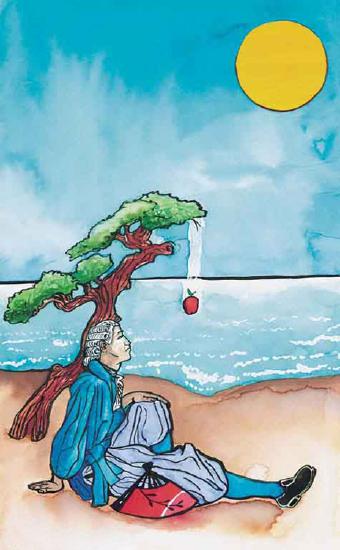
The gravitational force is relatively simple. It is always attractive, and it depends only on the masses involved and the distance between them. Stated in modern language, Newton’s universal law of gravitation states that every particle in the universe attracts every other particle with a force along a line joining them. The force is directly proportional to the product of their masses and inversely proportional to the square of the distance between them.
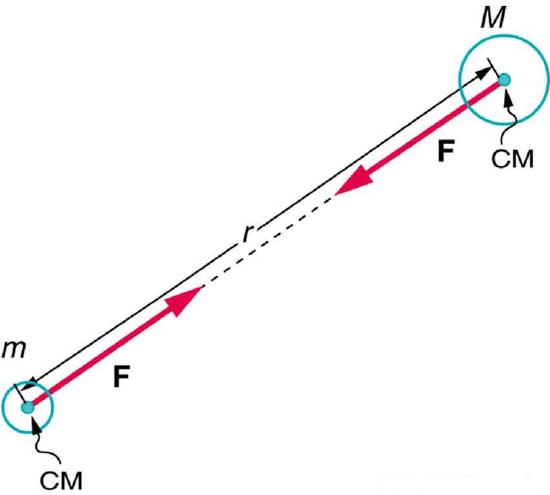
MISCONCEPTION ALERT
The magnitude of the force on each object (one has larger mass than the other) is the same, consistent with Newton’s third law.
The bodies we are dealing with tend to be large. To simplify the situation we assume that the body acts as if its entire mass is concentrated at one specific point called the center of mass (CM). For two bodies having masses m and M with a distance r between their centers of mass, the equation for Newton’s universal law of gravitation is
F=GmMr2,
where F is the magnitude of the gravitational force and G is a proportionality factor called the gravitational constant. G is a universal gravitational constant—that is, it is thought to be the same everywhere in the universe. It has been measured experimentally to be
G=6.673×10−11N⋅m2 kg2
in SI units. Note that the units of G are such that a force in newtons is obtained from F=GmMr2, when considering masses in kilograms and distance in meters. For example, two 1.000 kg masses separated by 1.000 m will experience a gravitational attraction of 6.673×10−11 N. This is an extraordinarily small force. The small magnitude of the gravitational force is consistent with everyday experience. We are unaware that even large objects like mountains exert gravitational forces on us. In fact, our body weight is the force of attraction of the entire Earth on us with a mass of 5.98×1024 kg.
Recall that the acceleration due to gravity g is about 9.80 m/s2 on Earth. We can now determine why this is so. The weight of an object mg is the gravitational force between it and Earth. Substituting mg for F in Newton’s universal law of gravitation gives
mg=GmMr2,
where M is the mass of the object, M is the mass of Earth, and r is the distance to the center of Earth (the distance between the centers of mass of the object and Earth). See Figure 2.9.3. The mass M of the object cancels, leaving an equation for g:
g=GMr2.
Substituting known values for Earth’s mass and radius (to three significant figures),
g=(6.67×10−11N⋅m2 kg2)×5.98×1024 kg(6.38×106 m)2,
and we obtain a value for the acceleration of a falling body:
g=9.80 m/s2.
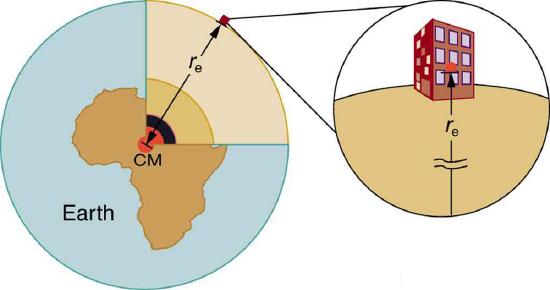
This is the expected value and is independent of the body’s mass. Newton’s law of gravitation takes Galileo’s observation that all masses fall with the same acceleration a step further, explaining the observation in terms of a force that causes objects to fall—in fact, in terms of a universally existing force of attraction between masses.
TAKE-HOME EXPERIMENT
Take a marble, a ball, and a spoon and drop them from the same height. Do they hit the floor at the same time? If you drop a piece of paper as well, does it behave like the other objects? Explain your observations.
Example 2.9.1: Earth’s Gravitational Force on a Mass
(a) Determine the weight of a 5.00 kg rock when on Earth's surface.
(b) Determine the weight of a 5.00 kg rock when 3620 km above the surface of Earth.
Strategy for (a)
Use acceleration due to gravity near Earth's surface and Newton's second law.
Solution for (a)
F=mg=5.00 kg×9.80 m/s2=49.0 N
Strategy for (b)
Use Newton’s universal law of gravitation. Remember that distance is from the center of Earth. In this case the distance is 6380 km + 3620 km = 10,000 km = 1.00×107 m.
Solution for (b)
F=GmMr2=(6.673×10−11N⋅m2 kg2)(5.00 kg)(5.98×1024 kg)(1.00×107 m)2=20.0 N
Tides
Ocean tides are one very observable result of the Moon’s gravity acting on Earth. Figure 2.9.4 is a simplified drawing of the Moon’s position relative to the tides. Because water easily flows on Earth’s surface, a high tide is created on the side of Earth nearest to the Moon, where the Moon’s gravitational pull is strongest. Why is there also a high tide on the opposite side of Earth? The answer is that Earth is pulled toward the Moon more than the water on the far side, because Earth is closer to the Moon. So the water on the side of Earth closest to the Moon is pulled away from Earth, and Earth is pulled away from water on the far side. As Earth rotates, the tidal bulge (an effect of the tidal forces between an orbiting natural satellite and the primary planet that it orbits) keeps its orientation with the Moon. Thus there are two tides per day (the actual tidal period is about 12 hours and 25.2 minutes), because the Moon moves in its orbit each day as well).
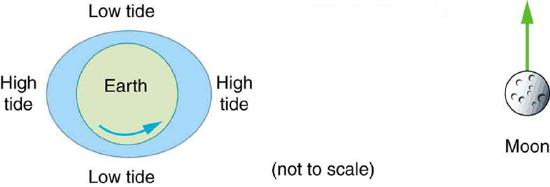
The Sun also affects tides, although it has about half the effect of the Moon. However, the largest tides, called spring tides, occur when Earth, the Moon, and the Sun are aligned. The smallest tides, called neap tides, occur when the Sun is at a 90∘ angle to the Earth-Moon alignment.
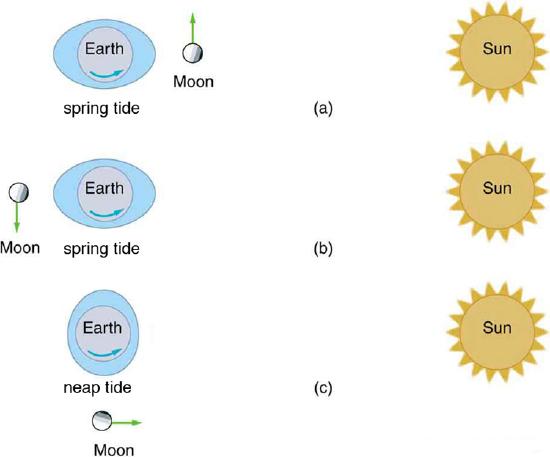
Tides are not unique to Earth but occur in many astronomical systems. The most extreme tides occur where the gravitational force is the strongest and varies most rapidly, such as near black holes (see Figure 2.9.6). A few likely candidates for black holes have been observed in our galaxy. These have masses greater than the Sun but have diameters only a few kilometers across. The tidal forces near them are so great that they can actually tear matter from a companion star.
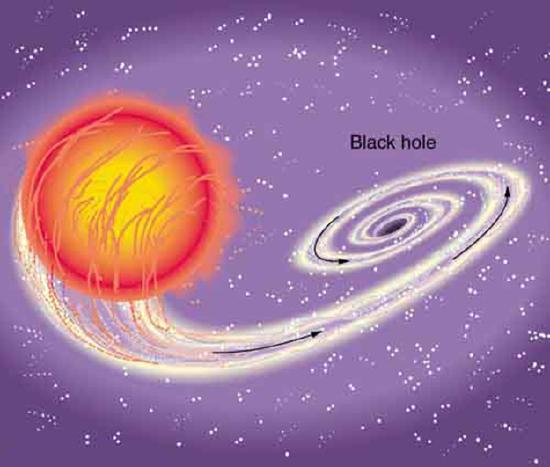
”Weightlessness” and Microgravity
You may have seen images of astronauts in International Space Station, floating in their environment. What is the effect of “weightlessness” upon an astronaut who is in orbit for months? Or what about the effect of weightlessness upon plant growth? Weightlessness doesn’t mean that an astronaut is not being acted upon by the gravitational force. There is no “zero gravity” in an astronaut’s orbit. The term just means that the astronaut is in free-fall, accelerating with the acceleration due to gravity. If an elevator cable breaks, the passengers inside will be in free fall and will experience weightlessness. You can experience short periods of weightlessness in some rides in amusement parks, and the commercial “zero-G” airplane rides simulate this experience of weightlessness about 20 seconds at a time.
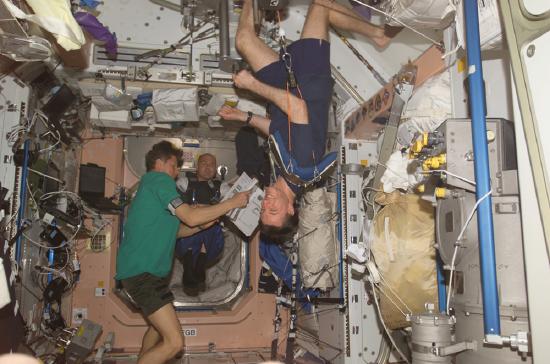
Microgravity refers to an environment in which the acceleration of a body due to non-gravitational forces is small compared with that produced by Earth on its surface. Many interesting biology and physics topics have been studied over the past three decades in the presence of microgravity. Of immediate concern is the effect on astronauts of extended times in outer space, such as at the International Space Station. Researchers have observed that muscles will atrophy (waste away) in this environment. There is also a corresponding loss of bone mass. Study continues on cardiovascular adaptation to space flight. On Earth, blood pressure is usually higher in the feet than in the head, because the higher column of blood exerts a downward force on it, due to gravity. When standing, 70% of your blood is below the level of the heart, while in a horizontal position, just the opposite occurs. What difference does the absence of this pressure differential have upon the heart?
Some findings in human physiology in space can be clinically important to the management of diseases back on Earth. On a somewhat negative note, spaceflight is known to affect the human immune system, possibly making the crew members more vulnerable to infectious diseases. Experiments flown in space also have shown that some bacteria grow faster in microgravity than they do on Earth. However, on a positive note, studies indicate that microbial antibiotic production can increase by a factor of two in space-grown cultures. One hopes to be able to understand these mechanisms so that similar successes can be achieved on the ground. In another area of physics space research, inorganic crystals and protein crystals have been grown in outer space that have much higher quality than any grown on Earth, so crystallography studies on their structure can yield much better results.
Plants have evolved with the stimulus of gravity and with gravity sensors. Roots grow downward and shoots grow upward. Plants might be able to provide a life support system for long duration space missions by regenerating the atmosphere, purifying water, and producing food. Some studies have indicated that plant growth and development are not affected by gravity, but there is still uncertainty about structural changes in plants grown in a microgravity environment.
Section Summary
- Newton’s universal law of gravitation: Every particle in the universe attracts every other particle with a force along a line joining them. The force is directly proportional to the product of their masses and inversely proportional to the square of the distance between them. In equation form, this is
F=GmMr2,
where F is the magnitude of the gravitational force. G is the gravitational constant, given by G=6.673×10−11 N⋅m2/kg2.
- Newton’s law of gravitation applies universally.
Glossary
- gravitational constant, G
- a proportionality factor used in the equation for Newton’s universal law of gravitation; it is a universal constant—that is, it is thought to be the same everywhere in the universe
- center of mass
- the point where the entire mass of an object can be thought to be concentrated
- microgravity
- an environment in which the acceleration of a body due to non-gravitational forces is small compared with that produced by Earth on its surface
- Newton’s universal law of gravitation
- every particle in the universe attracts every other particle with a force along a line joining them; the force is directly proportional to the product of their masses and inversely proportional to the square of the distance between them


